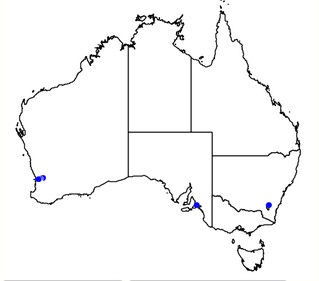Difference between revisions of "Acacia aphylla"
(→Geographic distribution) |
|||
| Line 12: | Line 12: | ||
It occurs at two general localities: the Hidden Valley area in the Helena R. valley, several kilometres downstream from Mundaring Weir; and Spencers Brook, S of Northam (Court 1978; Leigh et al. 1984; Brown et al. 1998). It is found in Clackline and Mokine NRs, both containing less than 1000 plants (Briggs & Leigh 1996). | It occurs at two general localities: the Hidden Valley area in the Helena R. valley, several kilometres downstream from Mundaring Weir; and Spencers Brook, S of Northam (Court 1978; Leigh et al. 1984; Brown et al. 1998). It is found in Clackline and Mokine NRs, both containing less than 1000 plants (Briggs & Leigh 1996). | ||
| + | |||
| + | [[File:aphylla-map.jpg]] | ||
== Identification == | == Identification == | ||
Latest revision as of 07:19, 23 January 2015
Contents
General Plant Info
Acacia aphylla, sometimes referred to as "Reindeer Bush" with it foliage similar in appearance to reindeer’s antlers, otherwise known as "Leafless Rock Wattle", "Twisted Desert Wattle" or "Live Wire", is an extraordinary looking Acacia.
The name ‘aphylla’ means without leaves, do to it's absence of phyllodes. It looks bare, and really prickly, but it’s actually quite soft.
It was recorded as rare in 1950 and after 1992 it was listed as vulnerable(Wildlife Conservation Act 1950 (Western Australia): September 2013), and so protected under the Endangered species Protection Act 1992.
Geographic distribution
Known only from one population in the Darling Ra. E of Perth and also from near Northam, south-western W.A, two areas only 60 km apart. Gazetted a rare species in W.A. Confined to granite outcrops on hillsides, in open eucalypt woodland; sometimes growing from crevices within the granite.
It occurs at two general localities: the Hidden Valley area in the Helena R. valley, several kilometres downstream from Mundaring Weir; and Spencers Brook, S of Northam (Court 1978; Leigh et al. 1984; Brown et al. 1998). It is found in Clackline and Mokine NRs, both containing less than 1000 plants (Briggs & Leigh 1996).
Identification
Divaricately branched shrub to 2.3 m high. Branchlets rigid, terete, very obscurely ribbed, smooth, glaucous, pruinose, glabrous, coarsely pungent.
Phyllodes absent.
Inflorescences simple, 1 per axil; peduncles 7–10 mm long, glabrous; heads globular, 20–30-flowered, bright light golden. Flowers 5-merous; sepals free. Flowers from July-Oct
Pods linear, 3–9 cm long, 3–4 mm wide, coriaceous, faintly pruinose, glabrous. Pods mature Dec.-Mar. (Kelly et al 1990) and mature pods have been collected in May and Oct.
Seeds longitudinal, oblong, 4–4.5 mm long, subshiny, black, arillate.
Alkaloid content
Other uses
Extraction
Cultivation
Acacia aphylla is fast growing to a about 1 meter in height and width, within 1 to 3 years , during which time they are likely to be at their best, visually to us anyway. By this ideal size (for many growers), plants flower readily in exposed situations, after which a light to heavy prune is recommended to keep any desired shape or height, as well as contributing to an extension of the plants life.
Suppliers
Links
http://www.worldwidewattle.com/speciesgallery/aphylla.php?id=3220
http://australiansucculents.com/articles-news/acacia/acacia-aphylla
